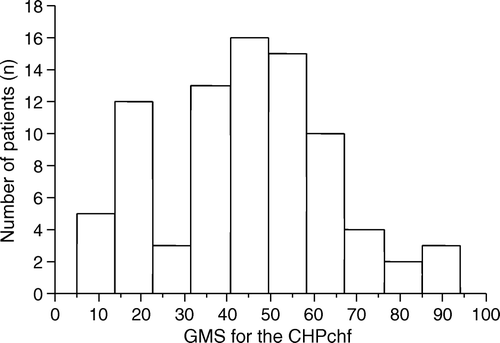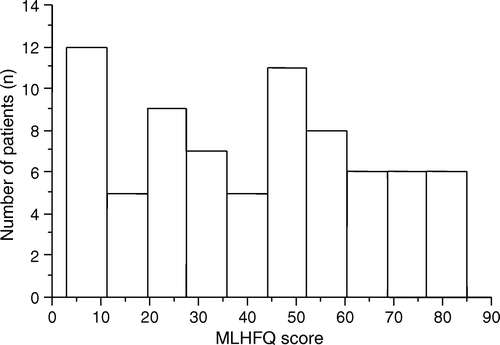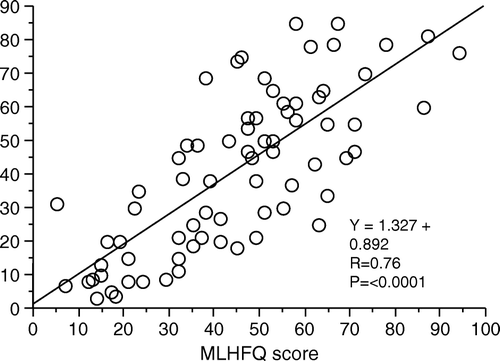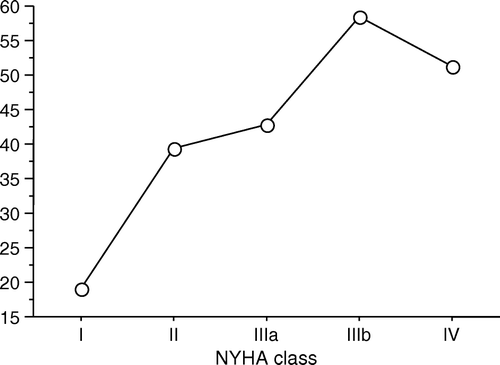Abstract
Objective. To study the validity and reliability of the new disease-specific extension of the CHP, Cardiac Health Profile congestive heart failure (CHPchf), used to assess QoL specifically for patients with heart failure. Methods. Eighty-three consecutive patients with chronic heart failure were enrolled. Criteria and construct validity were studied by correlating the Global Mean Score (GMS) for the CHPchf with the total sum score of the Minnesota Living with Heart Failure Questionnaire (MLHFQ) and other measures predicted to correlate with QoL. Reliability was evaluated on the basis of internal consistency. Results. Significant correlations for CHPchf were found with MLHFQ (r=0.76, p=<0.0001), the Boston Heart Failure Score (BHFS) (p<0.001), the generic second section of the CHP, maximal workload at exercise test (p<0.05) and the New York Heart Association (NYHA) classification (p<0.01). Cronbach′s α was calculated to 0.82. Conclusions. CHPchf was shown to be valid and reliable. CHPchf has favourable psychometric properties. Further studies are needed to explore its discriminative abilities.
Measurement of Quality of Life (QoL) is today regarded as essential in clinical evaluations Citation1, Citation2. Recent studies show that QoL is important when aiming to monitor clinical change Citation3 and that it predicts morbidity as well as mortality Citation4, increasing recognition of the concept even more. There is general agreement that QoL assessments should cover certain domains, in essence physical status, functional abilities, general well-being, social interactions, psychological/emotional status and somatic symptoms Citation5–9. Besides being valid and reliable, a questionnaire assessing QoL must be able to detect differences between patients and to respond to changes over time for a given patient or patient population. Disease-specific instruments focus on aspects of the health status that are specific for the disease of primary interest. Such an instrument is more responsive and therefore clinically more relevant Citation9. Only a few validated disease-specific measuring instruments exist; the Minnesota Living with Heart Failure Questionnaire (MLHFQ) is probably the most widely used Citation10, Citation11. A Swedish version has recently been validated Citation12. Although its validity and reliability have been demonstrated in several studies, it may lack sensitivity Citation13. Factor analysis has shown that several items do not constitute meaningful clusters Citation11, Citation14 which could explain this lack of sensitivity. To improve the psychometric properties they may need to be excluded Citation15. Unpublished results indicate a lack of unidimensionality (meaning that the items in the test do not seem to measure the same thing) and that it differentiates between the sexes and different age groups in a way that is not adequate (K. Franzén, pers. comm., May 18, 2006).
The Cardiac Health Profile (CHP) was developed and validated to assess QoL in patients with heart disease in general; it includes a disease-specific section for assessing QoL in patients with angina pectoris Citation16. It is in use and has shown favorable psychometric properties Citation17–22. The CHP is made up of three parts: Part I assesses subjectively reported functional ability, part II measures generic QoL for patients with heart disease in general; and part III measures disease-specific QoL. Different versions are accordingly used, depending on the type of heart disease in the study population. An advantage of the CHP is that different heart conditions can be compared in terms of generic QoL, and QoL can be related to the patient's subjectively reported functional capacity. This report presents data regarding validity and reliability for the CHP's disease-specific part for congestive heart failure (CHPchf).
Material and methods
Definition
Disease-specific QoL is defined as how the patient's disease influences his/her subjective perception of the degrees of physical, psychological and social well-being.
Study population
Any patients with congestive heart failure were included that did not meet the following exclusion criteria:
Patients not fluent with the Swedish native language;
Patients with dementia, psychiatric disease or other condition making it impossible to participate.
The questionnaire
The questionnaire consists of three parts. The first concerns the patient's subjectively reported degree of fatigue, palpitation or dyspnea in connection with physical activity according to the NYHA classification Citation23. It thus constitutes a redirection of the original NYHA classification, towards the patient instead of the physician. NYHA III is divided into an A and a B category, as shown in . The second part consists of 16 questions asking the respondent to indicate his/her situation by placing an X on a Visual Analogous Scale (VAS), a 100 mm long line with verbal “anchors” expressing extremes at either end. This part, which has been validated earlier, constitutes the generic part Citation16. The third part (CHPchf) consists of ten questions requesting the same type of response as in part II. To further illustrate how the verbal anchors fit into the Visual Analogous Scale: Item number reads “Are you often tired?”. The patient can then choose to place his/her mark anywhere from the very left extreme of the line where the words “no never” are written, to the opposite right extreme with the words “yes always”. Low CHP scores (where the patient places the mark to the left) indicate a good QoL, high scores a poor QoL. Standardised mean scores of the second and third parts are obtained by summing the responses and by measuring the distance in millimetres from the left end to the X mark for each item. The total is divided by the number of answered items to arrive at the global mean score (GMS). The questions in the disease-specific part are shown in .
Table I. Classification of cardiovascular disability according to the New York Heart Associations functional classification in the Cardiac Health Profile.
Table II. Questions in the CHPchf
Item selection
An original pool of about 17 items was carefully selected by Bert Andersson and Peter Währborg, both cardiologists with a long clinical experience, which proposed items relevant in the evaluation of quality of life in patients with congestive heart failure. This was done through discussions with patients in the clinic where the patients were actively asked to express the experienced impact of congestive heart failure on their quality of life. The original pool of items was then tried on approximately 30 patients.
The final ten questions were selected by the authors, based on the following criteria:
the item should mirror the study's operational definition of quality of life;
the item should be easy to understand; and
the item should have good psychometric qualities i.e. be related to the overall result and be normally distributed (implying that it is discriminative).
Procedure and laboratory methods
The European Guidelines Citation24 for the diagnosis of heart failure were applied to ensure correct recognition of the presence of heart failure.
The Cardiac Health Profile and a Swedish version of the Minnesota Living with Heart Failure Questionnaire (MLHFQ) were handed out consecutively to patients attending the out-patient clinic, the cardiology ward and the heart-transplantation ward. The patients were given approximately 10 min to complete the CHPchf. Patients that answered less than 75% of the questions were excluded. The MLHFQ is a 21-item scale in Likert format for assessing the disease's impact on various aspects of life quality Citation11 with a maximum possible score of 105. The clinical history was recorded and the Boston Heart Failure Score (BHFS) Citation25 was calculated. NYHA class was recorded and a chest x-ray was performed for calculation of the BHFS. Left Ventricular Ejection Fraction (LVEF) was calculated by means of echocardiography, using the Teichholz formula Citation26 or the Simpson formula Citation27. Patients, who were physically capable to do so, performed a graded exercise test on an ergometer bicycle, starting at a work load of 20 or 30 W and increasing the load by 10 W each minute.
Power calculation
The estimation of the study population was based on finding a probable significant correlation between CHPchf and the MLHFQ, indicating good content validity.
Statistical methods
We used Statview, SAS institute software version 5.0.1.0. P-values < 0.05 were regarded as significant. Standard descriptive statistics were applied in and and and except for the correlations between different items and the Global Mean Score of CHPchf which was assessed using Pearson′s correlation coefficient (r). Simple regression analysis and ANalysis Of VAriance (ANOVA) were performed in and respectively. Reliability was evaluated on the basis of internal consistency, i.e. Cronbach′s α Citation28. Cronbach′s α indicates internal consistency, i.e. the extent to which a set of test items can be treated as measuring a single model parameter and is applied by a random assortment of scale items into multiple split-half comparisons.
Figure 1. Frequency distribution for Global Mean Score in the CHPchf. CHPchf: Cardiac Health Profile congestive heart failure, GMS: Global mean score, n: number.

Figure 2. Frequency distribution for total sum score in the Minnesota Living with Heart Failure Questionnaire. n: number, MLHFQ: Minnesota Living With Heart Failure Questionnaire.

Figure 3. Correlation between the Global Mean Score of the CHPchf and the total sum score of MLHFQ. GMS: Global Mean Score, MLHFQ: Minnesota Living With Heart Failure Questionnaire.

Table III. Characteristics of patient population (n = 83).
Table IV. Descriptive data for each item in CHPchf.
Table V. Correlation between GMS for CHPchf with GMS for the generic part of the CHP and clinical variables.
Results
Eighty-seven consecutive patients with chronic heart failure from the out-patient clinic, a cardiology ward and the heart-transplantation ward at Sahlgrenska University Hospital were enrolled in the study from March to August 1999. Four patients were excluded after inclusion as they failed to reach the lower level of 75% with regard to the proportion of questions needed to be answered.
Descriptive data
Patient characteristics concerning clinical history, LVEF, maximum workload in graded exercise test and BHFS are shown in . GMS for the generic second part of the CHP was in this group 36±16, which is almost identical with the group of angina pectoris patients studied in the validation study for part II (36±17) and significantly different from the value for a healthy control group (23±11) Citation16. Descriptive data for each item of the CHPchf are shown in . The highest scores were for items 7 (Has your heart problem affected your outlook on life?) and 3 (Do you get out of breath easily?). The lowest scores were for items 5 (Do you sometimes fear dying?) and 6 (Do you have a good appetite?). The frequency distribution for the Global Mean Score for CHPchf in the population is shown in . The frequency distribution for MLHFQ is shown in , with a mean score of 41±24.
Key measurement properties
Three aspects were assessed: validity, reliability and sensitivity.
Validity
Content validity was addressed by the procedure described for item selection. Both the original pool of items and the final ten items in the questionnaire were selected by clinicians experienced in the field. Criterion and construct validity was studied by comparing the GMS for the CHPchf with the total sum score of MLHFQ (). A highly significant correlation was found (r = 0.76, p = < 0.0001). Correlations with clinical variables are shown in . Significant correlations were found with the BHFS (p < 0.001), the generic second part of the CHP, maximal workload at exercise test (p < 0.05) and NYHA classification (p < 0.01). There was no significant correlation with LVEF.
Reliability
Reliability was addressed by analysing internal consistency, i.e. the extent to which different items within the questionnaire (part III) are assessing the same content or characteristic. Cronbach′s α was applied and the overall Cronbach α coefficient was 0.82.
Sensitivity
Sensitivity was approached in a limited way, since no intervention was performed in this study. The GMS in relation to NYHA class is shown in . The mean of the GMS for patients in NYHA class I was 19±12, in NYHA class II 40±23, in NYHA class IIIA 43±21, in NYHA class IIIB 58±18 and in NYHA class IV 51±9.
Discussion
The present study concerns a new health-related and disease-specific questionnaire for patients with chronic heart failure, the CHPchf. Its validation was based on clinically well-known manifestations of the disease. Evaluation of criteria and construct validity is based on established methods for assessing somatic consequences of heart failure, such as physical capacity (maximum work load in exercise test), BHFS and the NYHA classification. The questionnaire showed significant correlations with these criteria but not with LVEF. A correlation with LVEF was likewise not found in earlier studies aiming at evaluating quality of life in patients with chronic heart failure Citation29. The relationship of physical capacity to quality of life is disputed in the literature. Some reports argue that it is closely correlated Citation30, others that it is not Citation29. There is, however, evidence of an increased QoL after physical training programmes and when physical capacity has improved after pharmacological treatment Citation31, Citation32.
However, the questionnaire also contains items not related to somatic consequences of chronic heart failure. The scores were highest for the question concerning the patient's “outlook on life”.
Surprisingly low scores were found for the item concerning “fear of dying”. This might reflect good coping abilities in the patients or suppression/denial of the disease. The Minnesota Living with Heart Failure Questionnaire is probably the most commonly used questionnaire for assessing QoL in this group of patients. A comparison showed a convincingly good correlation between the two questionnaires.
Limitations
This study has a number of limitations. Given the fact that the patient sample constitutes of a high proportion of men (80%) and that a relatively large part was included from the transplantation ward (34%) lowering the mean age of the study population (61 years), the results may not be generalisable to the congestive heart failure population in general. However, all NYHA classes () are well represented with the majority of patients in NYHA class II and IIIA. The exercise test was not performed by 22 of the patients, which might interfere with the results. No systematic drop-out was found. The drop-out rate is simply a result of practical limitations in the daily clinical work. As shown in , there is a trend break between NYHA IIIb and NYHA IV. The reason may related to the fact that dimensioning of the study was not assessed with the aim to elucidate norm values for different NYHA classes but only to be able to correlate the global mean score of CHPchf and MLHFQ and was thus rather small. Even if the global mean score CHPchf was correlated to NYHA classes, it was not possible to permit conclusions for each class especially NYHA IV as it contained only 13 patients. A less direct indication of sensitivity than comparing NYHA classes constitutes a comparison of the frequency distributions for CHPchf () and MLHFQ. In it is evident that the former is bell shaped, with the highest scores around the centre of the x-axis, whereas for MLHFQ the distribution is flat and skewed to the left. Data from a Swedish material show a similar picture (U. Alehagen, pers. comm., May 18, 2006). This may indicate a difference in sensitivity, as a psychometric scale should be designed so that the frequency distribution is normal Citation7. Moreover, the Swedish version of the MLHFQ used in this study had not been validated before. This is a limitation because translation into another language has been shown to alter an instrument's psychometric properties Citation33. However, we compared our version with a Swedish version that was recently validated Citation12 and found they were similar.
CHPchf was shown to be valid and reliable. CHPchf has favourable psychometric properties. Future studies aiming at assessing QOL before and after an intervention or in a controlled setting are needed to explore its discriminative abilities.
Conflicts of interests
None declared. Approval date by the local ethics committee: 21/10/98, Registration number: R41298
References
- Doba N, Tomiyama H, Nakayama T. Drugs, heart failure and quality of life: What are we achieving? What should we be trying to achieve?. Drugs Aging. 1999; 14: 153–63
- Guyatt GH. Measurement of health-related quality of life in heart failure. J Am Coll Cardiol. 1993; 22(4 Suppl A)185A–191A
- Masoudi FA, Rumsfeld JS, Havranek EP, House JA, Peterson ED, Krumholz HM, et al. Age, functional capacity, and health-related quality of life in patients with heart failure. J Card Fail. 2004; 10: 368–73
- Mejhert M, Kahan T, Persson H, Edner M. Predicting readmissions and cardiovascular events in heart failure patients. Int J Cardiol. 2005.
- Ware JE, Jr. Standards for validating health measures: Definition and content. J Chronic Dis. 1987; 40: 473–80
- Patrick DL, Deyo RA. Generic and disease-specific measures in assessing health status and quality of life. Med Care. 1989; 27(3 Suppl)S217–S232
- Shumaker SA AR, Czajkowski SM. Psychological tests and scales. In: B S Quality of life assessments in clinical trials. New York: Raven Press; 1990. p 95–113.
- Mc Dowell I NC. A Guide to rating scales and questionnaires. Oxford University Press, New York 1987
- Guyatt GH, Bombardier C, Tugwell PX. Measuring disease-specific quality of life in clinical trials. Cmaj. 1986; 134: 889–95
- Guyatt GH, Nogradi S, Halcrow S, Singer J, Sullivan MJ, Fallen EL. Development and testing of a new measure of health status for clinical trials in heart failure. J Gen Intern Med. 1989; 4: 101–7
- Rector TS, Cohn JN. Assessment of patient outcome with the Minnesota Living with Heart Failure questionnaire: Reliability and validity during a randomized, double-blind, placebo-controlled trial of pimobendan. Pimobendan Multicenter Research Group. Am Heart J. 1992; 124: 1017–25
- Franzen K, Blomqvist K, Saveman BI. Impact of chronic heart failure on elderly persons’ daily life: A validation study. Eur J Cardiovasc Nurs. 2005.
- Riegel B, Moser DK, Glaser D, Carlson B, Deaton C, Armola R, et al. The Minnesota Living With Heart Failure Questionnaire: Sensitivity to differences and responsiveness to intervention intensity in a clinical population. Nurs Res. 2002; 51: 209–18
- Middel B, Bouma J, de Jongste M, van Sonderen E, Niemeijer MG, Crijns H, et al. Psychometric properties of the Minnesota Living with Heart Failure Questionnaire (MLHF-Q). Clin Rehabil. 2001; 15: 489–500
- Heo S, Moser DK, Riegel B, Hall LA, Christman N. Testing the psychometric properties of the Minnesota Living with Heart Failure questionnaire. Nurs Res. 2005; 54: 265–72
- Wahrborg P, Emanuelsson H. The cardiac health profile: Content, reliability and validity of a new disease-specific quality of life questionnaire. Coron Artery Dis. 1996; 7: 823–9
- Bengtsson I, Hagman M, Wahrborg P, Wedel H. Lasting impact on health-related quality of life after a first myocardial infarction. Int J Cardiol. 2004; 97: 509–16
- Tingstrom PR, Kamwendo K, Bergdahl B. Effects of a problem-based learning rehabilitation programme on quality of life in patients with coronary artery disease. Eur J Cardiovasc Nurs. 2005; 4: 324–30
- Kiessling A, Henriksson P. Perceived cognitive function is a major determinant of health related quality of life in a non-selected population of patients with coronary artery disease–a principal components analysis. Qual Life Res. 2004; 13: 1621–31
- Bengtsson I, Hagman M, Wedel H. Age and angina as predictors of quality of life after myocardial infarction: A prospective comparative study. Scand Cardiovasc J. 2001; 35: 252–8
- Adamson DL, Webb CM, Collins P. Esterified estrogens combined with methyltestosterone improve emotional well-being in postmenopausal women with chest pain and normal coronary angiograms. Menopause. 2001; 8: 233–8
- Kiessling A. Quality of care and quality of life in coronary artery diseases. Stockholm. 2005
- The Criteria Committee of the New York Heart Association. Diseases of the heart and blood vessels; Nomenclature and criteria for diagnosis. Boston: Little Brown and Co.; 1994.
- Guidelines for the diagnosis of heart failure. The Task Force on Heart Failure of the European Society of Cardiology. Eur Heart J. 1995; 16: 741–51
- Carlson KJ, Lee DC, Goroll AH, Leahy M, Johnson RA. An analysis of physicians’ reasons for prescribing long-term digitalis therapy in outpatients. J Chronic Dis. 1985; 38: 733–9
- Teichholz LE, Kreulen T, Herman MV, Gorlin R. Problems in echocardiographic volume determinations: Echocardiographic-angiographic correlations in the presence of absence of asynergy. Am J Cardiol. 1976; 37: 7–11
- Schiller NB, Shah PM, Crawford M, DeMaria A, Devereux R, Feigenbaum H, et al. Recommendations for quantitation of the left ventricle by two-dimensional echocardiography. American Society of Echocardiography Committee on Standards, Subcommittee on Quantitation of Two-Dimensional Echocardiograms. J Am Soc Echocardiogr. 1989; 2: 358–67
- LJ R N., Gleser GC. A theory of generalizability: A liberalization of reliability theory. Br J Statist Psychol. 1963; 16: 137–63
- Wenger NK. Quality of life: Can it and should it be assessed in patients with heart failure?. Cardiology. 1989; 76: 391–8
- Davies SW, Jordan SL, Lipkin DP. Use of limb movement sensors as indicators of the level of everyday physical activity in chronic congestive heart failure. Am J Cardiol. 1992; 69: 1581–6
- Belardinelli R, Georgiou D, Cianci G, Purcaro A. Randomized, controlled trial of long-term moderate exercise training in chronic heart failure: Effects on functional capacity, quality of life, and clinical outcome. Circulation. 1999; 99: 1173–82
- Blackwood R, Mayou RA, Garnham JC, Armstrong C, Bryant B. Exercise capacity and quality of life in the treatment of heart failure. Clin Pharmacol Ther. 1990; 48: 325–32
- Streiner DL NG. Health measurement scales: A practical guide to their development and use2nd ed. Oxford University Press, New York 1995

